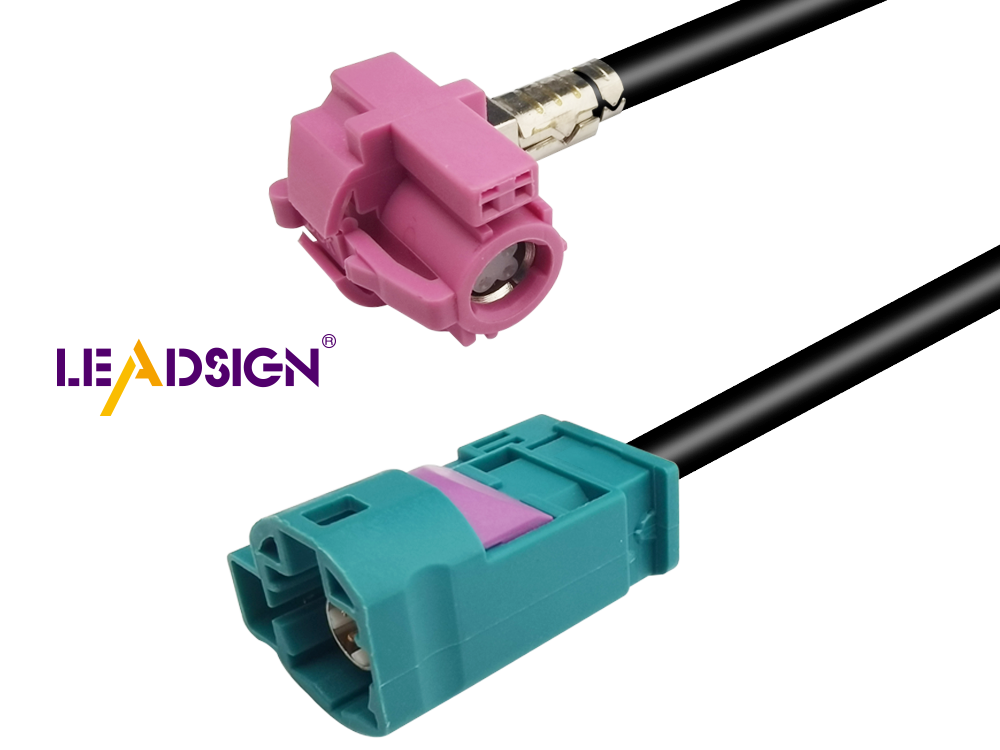Guide to FAKRA HSD Cable Specifications and Wire Connectors

Introducing the FAKRA HSD Cable Assemblies from LEADSIGN, a crucial component in automotive technology. These HSD cables are essential for rapid data transmission, ensuring that electronic systems remain seamlessly connected. LEADSIGN produces superior FAKRA HSD Cables that excel in performance. These cables provide reliable connectivity for infotainment systems, cameras, and screens. In modern vehicles, fast data transfer is vital, and these cables are compatible with USB 1.0, 2.0, 3.0, and LVDS systems. Their robust design ensures stability and efficiency within automotive environments.
Understanding FAKRA HSD Cables
Unique Design Features
Primary and Secondary Locks
FAKRA HSD cables have special locks to keep connections secure. These locks stop accidental unplugging, which is important in cars where stability is key. The design makes the connection reliable, giving users confidence in steady data flow. This strong lock system sets FAKRA HSD cables apart from others.
Shielding Capabilities
Shielding is crucial for FAKRA HSD cables' performance. They are fully shielded to block electromagnetic interference, ensuring clear signals. This shielding keeps data safe, especially in fast systems like car entertainment and media interfaces. The great shielding helps these cables meet tough car standards, perfect for new vehicles.
Practical Benefits
Ease of Installation
FAKRA HSD cables are easy to install because of their simple design. Color-coded housings prevent wrong connections, making setup easier. Installers can find the right spots quickly, lowering mistakes. This is helpful in complex car systems with many connections needed.
High Cable Holding Power
High holding power is a big plus for FAKRA HSD cables. They stay connected even during vibrations and temperature changes. This holding power keeps a stable link, vital for constant data flow needs. The design fits different car uses like GPS and GSM systems.
Suitability for Various Applications
FAKRA HSD cables work well in many situations because they are versatile. They support protocols like LVDS, USB, and Ethernet, fitting various systems. This flexibility lets them be used in many car applications from entertainment to cameras. Handling different protocols makes them a top choice for car makers.
Frequency Range
FAKRA HSD cables work well from DC to 6 GHz. This range helps in cars for things like telematics and multimedia. They send data fast, working great even when it's tough. Engineers make FAKRA HSD connectors fit car rules, giving a strong link. The connectors keep signals clear, which is key for camera systems.
Temperature Tolerance
FAKRA HSD cables handle temperatures from -40°C to +105°C. This makes them good for different car conditions. They work well in both hot and cold places, keeping data steady. Car engineers trust these cables for stable systems in changing weather. Their strong build supports GPS and GSM systems where being reliable is very important.
Customization and Supply Capabilities
Customization Choices
FAKRA HSD Cable Assemblies can be customized for different projects. You can pick cable types, connector styles, and lengths. This makes sure they fit well in cars. The connectors have colored plastic covers to prevent mistakes when connecting. These cables are great at blocking interference and keeping noise low, which helps them work well with fast data.
Supply Skills
LEADSIGN is good at making many FAKRA HSD Cable Assemblies. They make up to 200,000 each month. This means big orders are handled quickly. They follow strict rules for quality in car parts. The cables work with USB 1.0, 2.0, and 3.0, so they fit many uses. Their strong supply chain ensures on-time delivery and high quality every time.
Check out the advantages of FAKRA HSD Cable Assemblies for cars. Get free samples to see how they work and fit your needs. Contact LEADSIGN if you have questions or need help. Their team offers advice on customizing and supply options. These top-quality cables ensure strong connections in car systems. For more help, email info@leadsignauto.com. Learn how these cables boost car technology and meet industry rules.
See Also
Exploring Fakra Male Connectors: A Detailed Overview
Unveiling Fakra Connectors: Benefits, Uses, and Setup Advice
Decoding Fakra Connectors: An Extensive Overview
Mastering Fakra Female Connectors: An In-Depth Look
Essential Fakra Connectors: Fundamentals, Varieties, and Uses

